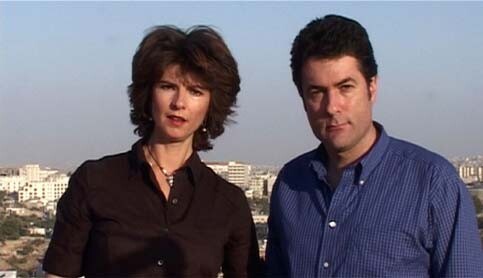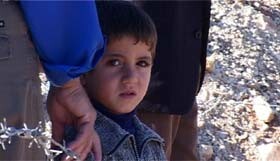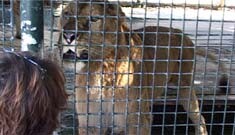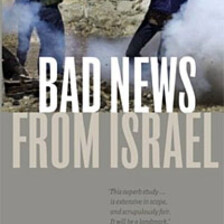The Electronic Intifada 2 August 2004

Documentary presenters Annabel McGoldrick and Jake Lynch.
“There is a huge distortion in the media here. Actually, they are looking for violence only, they are looking for bloodshed and they are looking for headlines. They don’t go behind the headlines; they don’t want to know the roots of the problem. They are not concentrating on the daily living of 3 million Palestinians, suffocated by the Israeli sanctions.” — Abdul Barry Atwan, Editor, Al-Quds Al Arabi
News from the Holy Land: Options and Consequences is a film that shows how journalists can improve their coverage of the Israel-Palestine conflict. It is geared towards aspiring journalists (although veteran journalists could learn a thing or two from it), introducing creative ways of covering the conflict. The film stresses that it is the lack of context in mainstream reporting of the conflict that leads to a process of polarization. This is partly because the media are only interested in violence and not the underlying processes which lead to the violence. As veteran Israeli peace activist Uri Avnery points out in the film, “the real influence of the media is in the way the news is written, its terminology, the angle of reporting … if you don’t kill somebody you’re not news.”
In the mainstream media there is little explanation offered as to why things happen the way they do. Little account is taken of the historical, cultural, and political processes which have led to the present impasse. Rarely do the media make any attempt to delve into issues behind the headlines, such as Israel’s illegal 37-year military occupation of Palestinian territory, its ongoing settlements policy, and the restrictions on Palestinian movement. There is hardly any explanation of, or background to, the Palestinian refugee problem or the rise of political Zionism and political Islam. For this, people have to rely on the occasional documentary (which is never enough).
In November 2003 I met two journalists, Jake Lynch and Annabel McGoldrick, who were running a 2-day course in peace journalism at the Bethlehem Media Centre. There was a group of 12 people in a room within the Lutheran Church where we had all gathered to listen, debate and discuss the role of the media in the Israel-Palestine conflict. The group consisted of Palestinians from the Diaspora and from Bethlehem, as well as foreigners who all had an interest in perceptions, distortions, and bias of the media when it comes to issues relating to everyday life in the occupied Palestinian territories. News from the Holy Land addresses some of the confusion and misinformation about the conflict and provides examples on how to improve its coverage.
Tim Lewellyn, a patron of Arab Media Watch (AMW) and former BBC Middle East correspondent, explains in the film that because of the way the dispute is reported, it appears to be “a struggle between two equal sides, more or less, two sides who both have right on their side, and who both have wrong on their side,” which is a gross oversimplification of the conflict. This is a view backed up by Professor Greg Philo’s study presented in his book Bad News from Israel, which finds that most Brits were confused over some of the very issues that lay at the heart of the Israel-Palestine conflict, such as who was occupying who, the nationality of the settlers, and the basic history of the conflict.

Film still: A young Palestinian boy queueing with his parents to get through an Israeli military checkpoint.
This is despite several binding UN Security Council resolutions condemning the settlements and the ongoing Israeli occupation, not to mention an advisory opinion by the world’s highest judicial body, the International Court of Justice, which concluded that the Israeli settlements in the occupied Palestinian territories, including East Jerusalem, have been established in breach of international law (para. 120) and that the construction of the wall, and its associated regime, are contrary to international law (para. 142).
It is well known that news coverage of the Israel-Palestine conflict is often subject to criticism and complaint, which is hardly surprising bearing in mind the points that have just been raised. As Lynch points out in the film, one of the reasons behind this is because reports presented to the viewing public as “balanced,” “neutral” and “objective” often, in fact, conceal crucial omissions and biases. In order to overcome this criticism, it is necessary to fill in the gaps missing in standard reports on the conflict and show the reality of life for those caught up in the violence - Israelis and Palestinians who live with it day in, day out.
Lynch and McGoldrick believe that in order to do this, a deliberate creative strategy is needed. To explain what they mean by this, they present a mock standard report and a mock alternative report. The standard report is what one would normally expect to see on the BBC, ITV or Sky News. The alternative report is slightly more extensive in that it covers the reality of life for those caught up in the conflict - Israel’s 37-year-old military occupation of Palestinian territory, military roadblocks, Israeli army service, the expansion of illegal Israeli settlements as well as the creation of new ones, the construction of a wall on occupied Palestinian land, and the impact of the conflict on Israeli and Palestinian society.
They use as an example the report of a suicide bombing in Jerusalem in August 2003. The standard report covered the main facts: where the bomber came from, how many people died, the outfall of the blast, and the reactions of Israeli and Palestinian officials, and then left it at that. The alternative report, however, covered the same issues but went into more detail to explain how Palestinian living conditions are greatly affected by the military occupation, such as the military roadblocks restricting people’s movement, the invasions, and curfews during which people can be locked in their homes for days on end. A “period of relative calm” only means Israelis aren’t dying, whereas Palestinian casualties and deaths continue on a daily basis.

Film still: Hava Halevi of Checkpoint Watch at Beit Furiq checkpoint near Nablus.

Film still: Presenter Annabel McGoldrick with the lion at the beleaguered Qalqilyazoo.
What Lynch and McGoldrick do is add context to their reports. They explain, but they do not condone, why things happen the way they do, which is better than just regurgitating information about who did what, where and when. They think journalists should cover the whole spectrum of Israeli and Palestinian society, rather than just reporting the extremes. When, for instance, an interview with a right-wing Israeli is undertaken, it is useful to counter his/her propaganda with those on the left of Israeli society who are searching for peace.
Little coverage is given to the inherent contradictions in Israeli and Palestinian society, which would break the stereotypes people have of one another, that plague the conflict and place obstacles in the path of peaceful reconciliation. In Bethlehem, Lynch interviewed the brother and mother of a suicide bomber. The bomber’s brother works with Palestinian children to use their creative talents to work for peace through art and craftwork. His brother chose the way of violence after his best friend died bleeding in his arms. A secular family whose children graduated from technical school, they are hardly the stereotypical Islamic fundamentalists. When questioned about her son, the mother of the suicide bomber said:
“Everyone’s child is precious to its parents — the way my kids are precious to me, their kids are precious to them as well. I didn’t expect my son to do this or I would have tried to stop him.”
Young Israelis are being drafted into the army, and in many cases have to man the very military roadblocks which Palestinians have to pass through on a daily basis. In many instances, this is the only direct contact they have with one another. These soldiers then have to go home to their parents and families. In recent years substantial numbers of Israelis like Yonni Ben Artzi (the nephew of former Israeli Prime Minister Benyamin Netanyahu) are refusing to serve in the occupied Palestinian territories, and many Palestinians are beginning to oppose violent acts of resistance. It is therefore clear that there is a substantial constituency for peace among both Israelis and Palestinians, and Lynch and McGoldrick think it is necessary to stress this point.
In the majority of situations, Israelis and Palestinians have to cooperate to get anything done. It’s not as if everyone is intent on killing each other. Within Israel there are many organizations like Gush Shalom, Rabbis for Human Rights, Taayush, and Women in Black (to name a few), who all oppose the occupation and who are more in touch with world public opinion than their own government. There are also organizations like the Ecumenical Accompaniment Volunteers, consisting mainly of foreigners, who assist Israelis and Palestinians in the search for peace.
Major news organizations should cover in more detail and with more regularity peaceful protests, acts of civil disobedience, and cooperation among Jews and Arabs, focusing on their actual living conditions rather than individual acts of violence. The mainstream media should also counter the arguments of extremists with those who are working for peace. It would help if major news organisations report on the illegality of the occupation and the settlements, and go into more depth in explaining the Palestinian refugee issue. For without a basic understanding of these essential facts, facts which have shaped the conflict, it will be very difficult for the average viewer (journalists included) to know what the conflict is really about.
Victor Kattan, a correspondent and member of Arab Media Watch’s advisory committee, can be reached at contactkattan@hotmail.com
For more information:
The full documentary runs for 48 minutes and is available on VHS. To obtain a copy of the video plus teaching notes, contact the distributor, Hawthorn Press, at HPressGlos@aol.com
Related links:




